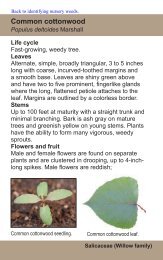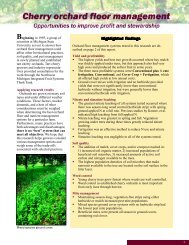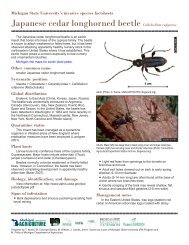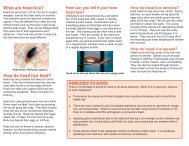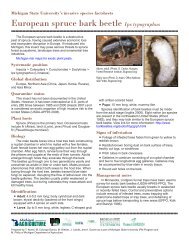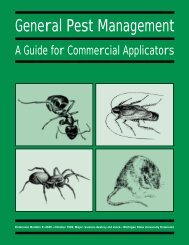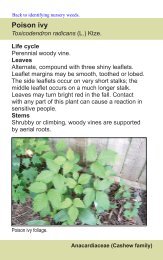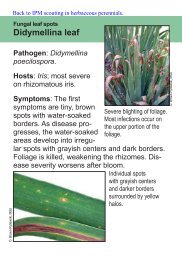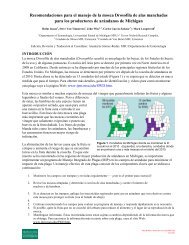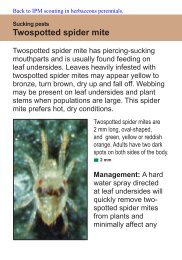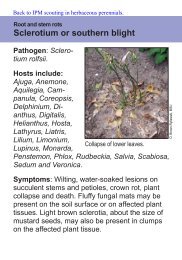CALIBRATION
CALIBRATION
CALIBRATION
You also want an ePaper? Increase the reach of your titles
YUMPU automatically turns print PDFs into web optimized ePapers that Google loves.
6. The average output of the nozzles for 14 seconds is:<br />
63 ounces = 16 ounces<br />
4 nozzles<br />
7. The spray rate, therefore, is equal to 16 gallons per acre.<br />
8. The spray rate is lower than the recommended range of<br />
20 to 30 gallons per acre stated on the label. The major<br />
change in output required should not be attempted by<br />
increasing pressure. You’ll need to either decrease<br />
travel speed (in which case you’ll also need to determine<br />
the new travel time) or increase nozzle tip size.<br />
Then determine the new average output.<br />
Amount of Pesticide to Add to the Tank<br />
Your next step is to determine the amount of pesticide<br />
to add to the spray tank. To do so, you need to know:<br />
■ The recommended rate.<br />
■ The capacity of the spray tank.<br />
■ The calibrated output of the sprayer.<br />
You just learned how to determine the output of your<br />
sprayer.<br />
The recommended rate is determined from the label.<br />
Rates are expressed either as the amount of pesticide<br />
product applied per acre (or area) or as the amount to<br />
mix with a certain volume of water (or other carrier).<br />
Example: Broadcast application. Pesticide A is recommended<br />
as a broadcast application at a rate of 2 quarts<br />
per acre. Your sprayer has a 200-gallon tank and is calibrated<br />
to apply 20 gallons per acre. How much Pesticide<br />
A should you add to the spray tank?<br />
1. Determine the number of acres you can spray with<br />
each tank, using the following formula:<br />
tank capacity (gallons per tank) = 200 = 10 acres<br />
Acres per tank =<br />
Spray rate (gallons per acre) 20<br />
2. Determine the amount of pesticide to add to each<br />
tank, using the following formula:<br />
Amount per tank = acres per tank x rate per acre.<br />
With each tank, you cover 10 acres and you want to<br />
apply 2 quarts of product per acre:<br />
Amount per tank = 10 x 2 = 20 quarts.<br />
You need to add 20 quarts (5 gallons) of Pesticide A to<br />
each tank load.<br />
Example: Broadcast application. Pesticide B is an 80<br />
percent wettable powder formulation. After reading the<br />
label, you decide to apply 12 pounds per acre for perennial<br />
weed control. The area to treat is 150 feet wide and<br />
180 feet long. Your backpack sprayer is equipped with a<br />
three-nozzle boom, has a 4-gallon tank, and is calibrated<br />
to apply 40 gallons per acre of spray solution. How much<br />
water and product do you add to the tank? (43,560 sq. ft.<br />
= 1 acre)<br />
1. Calculate the area to be treated as follows:<br />
150 x 180 feet = 27,000 square feet, which is equal to<br />
0.62 acres (27,000 ÷ 43,560)<br />
2. Calculate the amount of water needed to cover 0.62<br />
acres, using this formula:<br />
40 gallons Y gallons =<br />
1 acre 0.62 acre<br />
which is read as “40 gallons is to one acre as<br />
Y gallons is to 0.62 acre.”<br />
Cross-multiplying:<br />
(Y x 1) = (40 x 0.62) = 24.8 gallons to treat 0.62 acre<br />
3. With a 4-gallon tank, we will need more than six<br />
loads of solution; let’s plan to mix seven loads.<br />
24.8 gallons = 3.54 gallons per load<br />
7 loads<br />
4. If we were spraying an acre, we would need 12<br />
pounds of pesticide per 40 gallons of water (the peracre<br />
output of our sprayer). However, we will be<br />
spraying only 3.54 gallons at a time. To determine<br />
the amount of pesticide to add per tank load, use<br />
the following formula:<br />
12 pounds Y pounds =<br />
=<br />
40 gallons 3.54 gallons<br />
Y= 12 x 3.54 1.06 pounds of Pesticide B in each<br />
=<br />
40 tank load of 3.54 gallons<br />
Liquid Application on a Percentage Basis<br />
Occasionally pesticide recommendations are expressed<br />
as amount of product per a specified volume of water. Such<br />
rates are expressed as “volume/volume” equivalents or as<br />
a percentage of product in the spray solution.<br />
Example: Rate expressed as volume per volume.<br />
Pesticide C is recommended as a sanitary bin spray to<br />
control stored grain insects. Four gallons of product are<br />
recommended per 100 gallons of water. You want to prepare<br />
75 gallons of solution. How much Pesticide C do<br />
you mix with the 75 gallons of water?<br />
4 gallons Pesticide C Y gallons Pesticide C<br />
=<br />
100 gallons water 75 gallons water<br />
By cross multiplying:<br />
100 x Y = 75 x 4<br />
100 x Y = 300<br />
Y = 3 gallons of Pesticide C per 75 gallons<br />
of water<br />
GRANULAR APPLICATOR <strong>CALIBRATION</strong><br />
Occasionally, granular or pelleted pesticides are used<br />
for weed control. The need for accurate calibration is just<br />
as great for granular applicators as for sprayers.<br />
The application rate of granular applicators depends on<br />
the size of the metered opening, the speed of the agitator<br />
Chapter 4<br />
28<br />
Field Crop Pest Management



